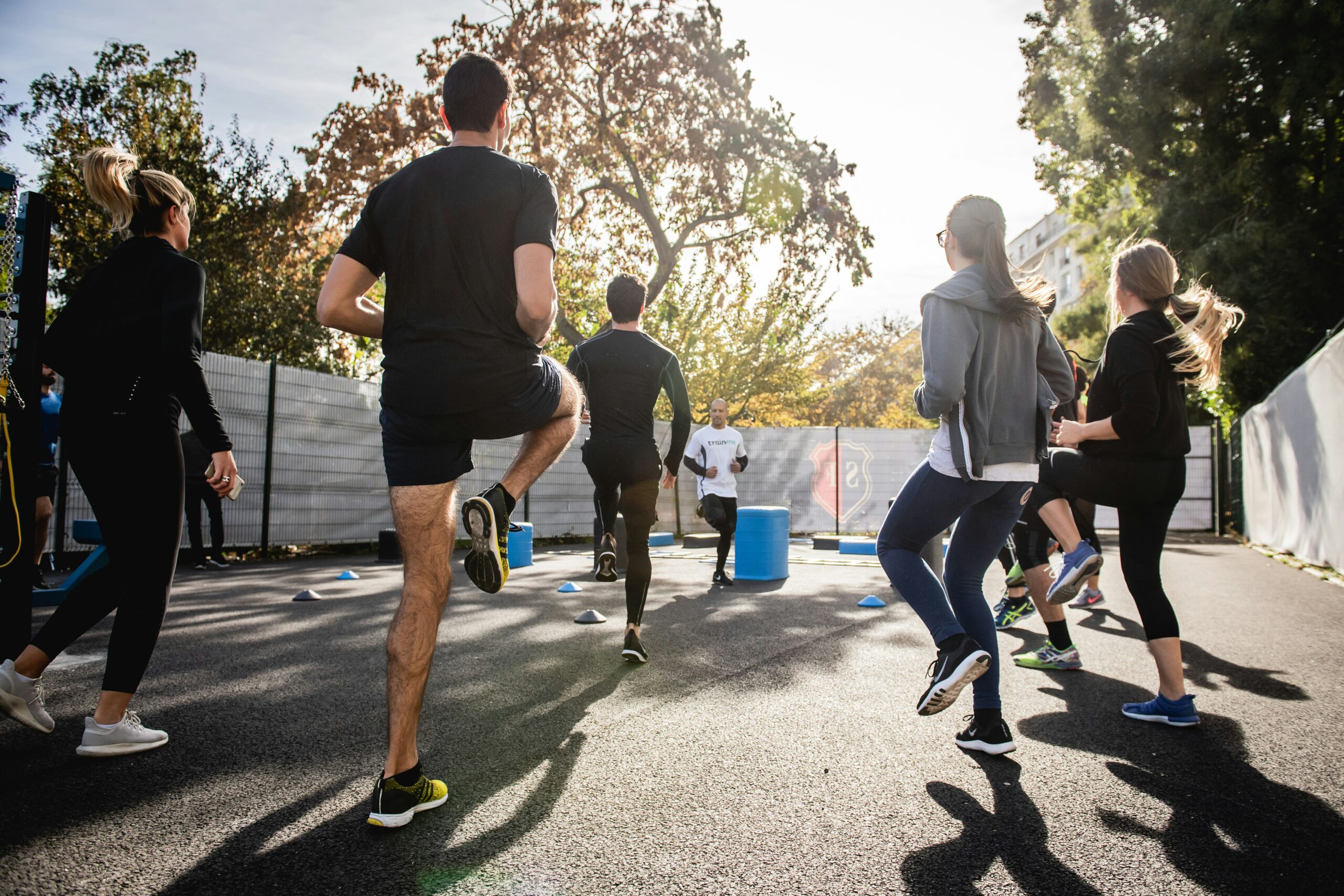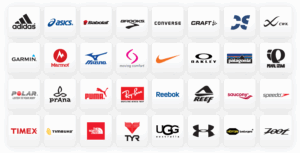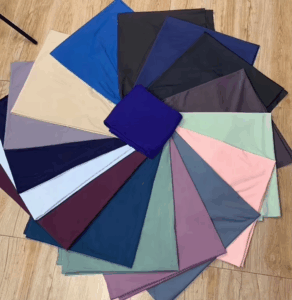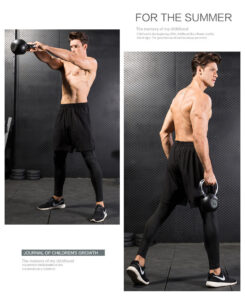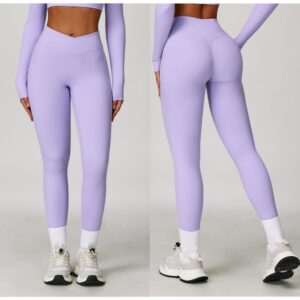Key differences:
- Sportswear: Focused on professional athletic performance, designed to meet specific sports requirements, emphasising functionality, durability, and competitive performance. Typically features advanced materials and technical designs to enhance athletic abilities.
- Activewear: Emphasises comfort, flexibility, and fashion in daily activities, balancing sports and casual scenarios. Designed for versatile wearability in low-to-moderate-intensity activities, prioritising ease of movement and everyday style.
I. Categories and Features of Sportswear
Main Categories:
- Running Gear
- Features: Exceptional breathability (e.g., mesh fabrics), lightweight, moisture-wicking materials to reduce wind resistance and enhance comfort during prolonged running. Some garments use advanced technologies like 3D knitting to optimize fit and airflow.
- Typical items: Running shoes (with cushioning and stability features), moisture-wicking T-shirts, compression tights (to reduce muscle fatigue), empty-top hats (to prevent hair interference), running skirts (usually with built-in shorts for safety).
- Design details: Reflective strips (for night running safety), compression technology (to enhance muscle support), rear waist pockets (for energy gels), and anatomical footbeds in shoes.
- Example tech materials: Polyester microfibers, Polygiene odour-control treatments, and breathable membranes like Gore-Tex Lite.
- Ball Sports Equipment
- Basketball: Loose-fitting cuts (e.g., drop-tail shirts) to allow for large arm movements, sweat-absorbing fabrics like Dri-FIT, mesh jerseys + shorts combo. Shoes feature high-traction soles and ankle support.
- Tennis: Dresses (common for women, with built-in shorts to prevent exposure), elastic fabrics (e.g., elastane blends), rapid moisture-wicking, breathable shoulder designs to prevent chafing. Racket sports shoes prioritise lateral stability.
- Soccer: Moisture-wicking jerseys with team logo embroidery, breathable fabric拼接 (e.g., polyester and spandex), compression shorts for muscle protection. Shin guards and soccer-specific cleats are essential accessories.
- Additional ball sports: Volleyball (quick-dry tops, wide armholes), baseball (padded uniforms, sun protection sleeves).
- Water Sports Gear
- Swimming: Professional swimsuits (high elasticity, waterproof, resistance reduction through hydrodynamic design), dive suits (insulated, UV protection, often with neoprene layers).
- Surf/Beachwear: Quick-dry sun protection clothing (UPF 50+), abrasion-resistant fabrics (e.g., nylon with recycled materials), one-piece designs for surfing, rash guards (protective tops).
- Example brands: Speedo’s Fastskin series, Rip Curl’s eco-friendly surf suits.
- Extreme Sports Equipment
- Skiing/Snowboarding: Windproof and waterproof coatings (e.g., H2No technology), insulated liners, high elasticity for jumps and turns. Helmets with MIPS impact protection and goggles with anti-fog coatings.
- Rock Climbing: Abrasion-resistant materials (e.g., Dyneema fibres), elastic cuts, form-fitting designs for grip. Climbing shoes feature sticky rubber soles and tight fits.
- Mountain Biking: Breathable padded shorts, protective knee/elbow pads, lightweight helmets with ventilation channels.
- Additional extreme sports: Paragliding (ventilated harnesses), mountaineering (4-layer Gore-Tex jackets).
- Training Gear
- Weightlifting/Strength Training: Supportive fabrics (e.g., Lycra, PowerFlex), form-fitting designs to enhance muscle awareness. Weightlifting belts for spinal support, wrist wraps for stability.
- Combat Sports: Breathable and durable (e.g., cotton-linen blends), loose pant legs for kicking movements. Boxing gloves with shock absorption, Muay Thai shorts with elastic waistbands.
- CrossFit/Gym Equipment: Versatile shoes with multi-directional traction, high-top support for Olympic lifts.
Common Features:
- High-performance fabrics (e.g., Gore-Tex, nylon, Coolmax).
- Professional design details (e.g., seamless construction, sweatbands, non-slip palm pads).
- Vibrant colours (team logos, professional aesthetics).
- Emphasis on competitiveness (e.g., reduced resistance, improved performance).
- Durable construction to withstand intense physical activity and frequent washing.
II. Categories and Features of Activewear
Main Categories:
- Yoga/Pilates Wear
- Features: High elasticity, four-way stretch fabrics (e.g., spandex, TENCEL lyocell), body-contouring for comfort and flexibility. Materials often prioritise softness and eco-friendly production.
- Typical items: Seamless leggings, “naked feel” yoga pants, supportive sports bras (with wide straps), high-waisted bottoms (for tummy control).
- Design details: Abdominal shaping lines, wide waistbands for security, thumbholes in tops for warmth retention. Many brands use recycled polyester or bamboo fibres.
- Example styles: Flowy joggers, crop tops with crisscross back details.
- Fitness/Training Apparel
- Features: Light to moderate support, moisture-wicking, balancing shaping and comfort. Ideal for activities like cycling, Pilates, or barre workouts.
- Typical items: Waist-trimming pants, medium-support sports bras, loose training T-shirts with thumbholes.
- Design details: Phone/card pockets, trendy color blocks (e.g., ombre effects), reflective accents for safety.
- Outdoor Casualwear
- Features: Windproof, light waterproofing, adaptable to temperature changes. Materials often blend function and style.
- Typical items: Lightweight windbreakers, hiking pants with stretchy waistbands, fleece hoodies with moisture-wicking liners.
- Design details: Adjustable hems, multiple pockets for storage,抗菌 treatments to resist odor.
- Example brands: Patagonia’s Nano-Air jackets, The North Face’s Apex Bionic series.
- Daily Casualwear
- Features: Comfortable and loose-fitting, prioritising fashion pairing. Can be mixed with streetwear for a “athleisure” look.
- Typical items: Athletic hoodies, wide-leg sweatpants, joggers, casual running shoes (e.g., Nike Daybreak).
- Design details: Minimalistic logos, solid colours or basic prints, high compatibility with everyday outfits. Some items feature anti-static properties.
- Multi-functional Hybrid Items
- Examples: Versatile leggings (can be worn under a blazer), lightweight down-filled jackets combining warmth and portability. Adaptive tops with zip-off sleeves for temperature flexibility.
- Tech innovations: Phase-changing materials that adjust to body heat, garments with built-in deodorant properties.
Common Features:
- Diverse fabrics (cotton blends, modal, recycled fibres).
- Fashion-forward designs (oversized silhouettes, trend colours, unique prints).
- Versatile scenarios (gym, commuting, shopping, light outdoor activities).
- Emphasis on comfort and multi-functionality (e.g., machine washable, wrinkle-resistant, easy care).
- Sustainability: Many activewear brands prioritise eco-friendly production (e.g., using recycled ocean plastic).
III. Summary: Key Differences and Complementarity
- Functionality & Scenarios:
- Sportswear: Designed for specific sports (e.g., waterproof swimming suits, breathable basketball jerseys). Optimised for high-intensity, competitive environments.
- Activewear: General movement + daily wear, balancing comfort and style. Ideal for activities like yoga, walking, or casual workouts.
- Example scenarios:
- Sportswear: Marathon running, professional tennis match, rock climbing competition.
- Activewear: Weekend hiking, dog walking, running errands.
- Materials & Details:
- Sportswear: Tech fabrics + specialised structures (e.g., built-in shorts in tennis skirts, compression zones).
- Activewear: Comfort fabrics + fashion elements (e.g., colour splicing, trendy accents).
- Material differences: Sportswear prioritises performance (e.g., Polygiene for odour control), while activewear may use softer blends (e.g., bamboo/cotton).
- Style & Pairing:
- Sportswear: Typically more professional, minimalist colours (e.g., neon, team colours). Pairing is often monochromatic or team-branded.
- Activewear: Looser, casual aesthetics, mixable with streetwear (e.g., leggings + denim jacket). Accessories like beanies and statement sneakers are common.
- Hybrid trends: Some brands merge the two, creating “performance leisurewear” (e.g., Lululemon’s athletic-inspired streetwear).
- Price Range & Durability:
- Sportswear: Generally higher priced due to advanced materials and specialised design. Durability is key (e.g., shoes with reinforced soles).
- Activewear: Price varies, with some luxury brands (e.g., Athleta) and affordable options (H&M Studio). Durability may be lower for casual items.
- Body Support & Performance:
- Sportswear: Features like compression, ergonomic padding, and stability structures to prevent injuries and enhance performance.
- Activewear: Light support for daily activities, prioritising freedom of movement over advanced athletic support.
Real-life examples:
- Running race: Wear professional shorts + moisture-wicking top (sportswear) + reflective gear for safety.
- Daily commute: Pair leggings, knitted coat(activewear) + comfortable sneakers.
- Gym training:
- High-intensity workouts (e.g., weightlifting): Sportswear (supportive tights, weightlifting shoes).
- Low-intensity workouts (e.g., yoga): Activewear (high-stretch leggings, breathable tops).
- Outdoor hiking: Activewear windbreaker + moisture-wicking pants + hiking shoes (with some sportswear features like grip soles).
IV. Additional Considerations
- Trend Integration:
- Sportswear: Slowly adopting fashion trends (e.g., neon colors, oversized logos), but maintaining performance as the core.
- Activewear: Heavily influenced by fashion, with designers collaborating on limited-edition collections (e.g., Nike x Off-White).
- Example trend: “Techleisure” — activewear with metallic finishes, futuristic cuts.
- Sustainability & Ethics:
- Both sectors are increasingly adopting eco-friendly materials (e.g., recycled PET bottles, organic cotton). Sportswear brands often invest in R&D for sustainable tech fabrics (e.g., PUMA’s evoKNIT).
- Activewear brands like Girlfriend Collective prioritise ethical manufacturing (e.g., fair labour practices).
- Customization & Innovation:
- Sportswear: Some brands offer customisation (e.g., personalised team jerseys, 3D-printed running shoes).
- Activewear: Trends include adaptive clothing (e.g., tops with convertible sleeves) and smart wearables integration (e.g., garments with built-in sensors).
- Target Markets:
- Sportswear: Athletes, serious enthusiasts, and team sports participants.
- Activewear: Broader audience: casual exercisers, fashion-conscious consumers, urban dwellers seeking versatile outfits.
V. How to Choose the Right Category?
- Identify Your Needs:
- High-intensity sports → Sportswear (e.g., soccer cleats, cycling bib shorts).
- Low-intensity activities → Activewear (e.g., walking, yoga).
- Mixed-use → Hybrid items (e.g., breathable jogging pants suitable for both workouts and casual outings).
- Material Checklist:
- Performance: Look for technical fabrics (e.g., Coolmax, Merino wool).
- Comfort: Prioritise softness and stretch (e.g., modal, spandex).
- Durability: Check for reinforced seams and abrasion-resistant coatings.
- Style vs. Functionality:
- If you prioritise aesthetics over intense sports, activewear is ideal. If you compete or train rigorously, invest in sportswear.
VI. Future Trends
- Smart Sportswear: Garments with embedded sensors to track metrics (e.g., heart rate, movement analysis).
- Sustainable Activewear: Brands using plant-based materials (e.g., algae-based fibres) and closed-loop recycling systems.
- Versatility Expansion: Activewear designed for more intense activities (e.g., high-support leggings for running) to blur the line between categories.
Conclusion
Sportswear and activewear serve distinct purposes, with the former prioritising peak athletic performance and the latter balancing comfort, style, and daily versatility. While they overlap in some areas (e.g., moisture-wicking fabrics), understanding their core differences helps consumers make informed choices. As technology advances and trends evolve, both sectors continue to innovate, offering more options for diverse lifestyles.
